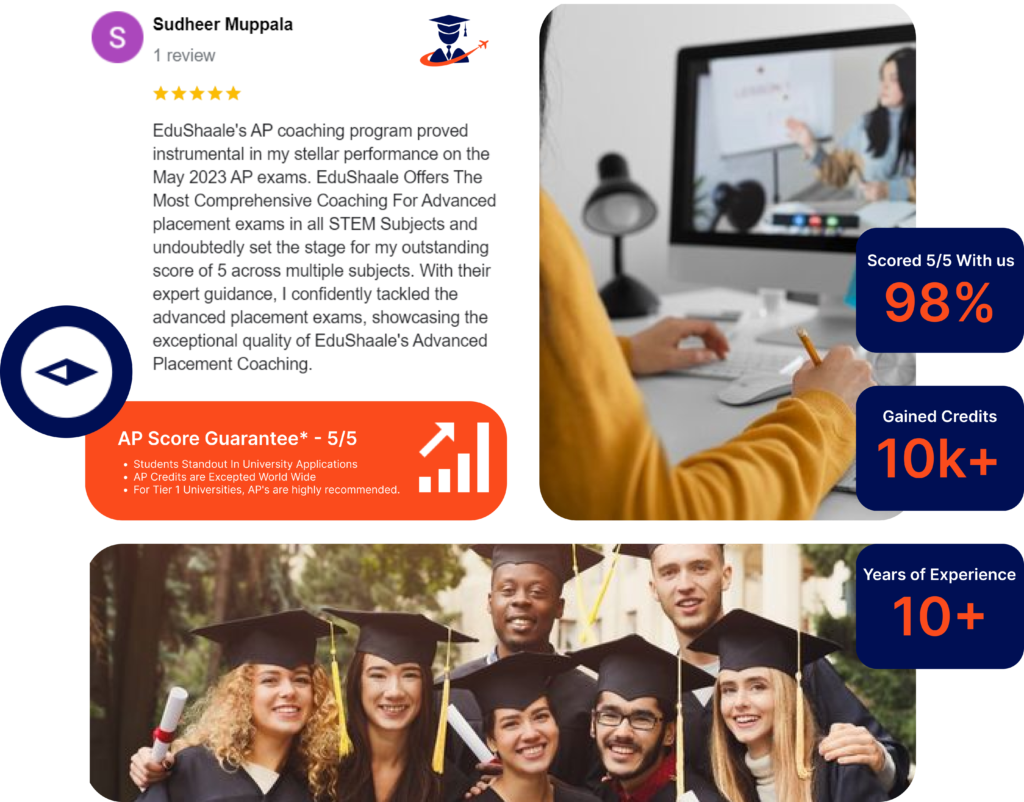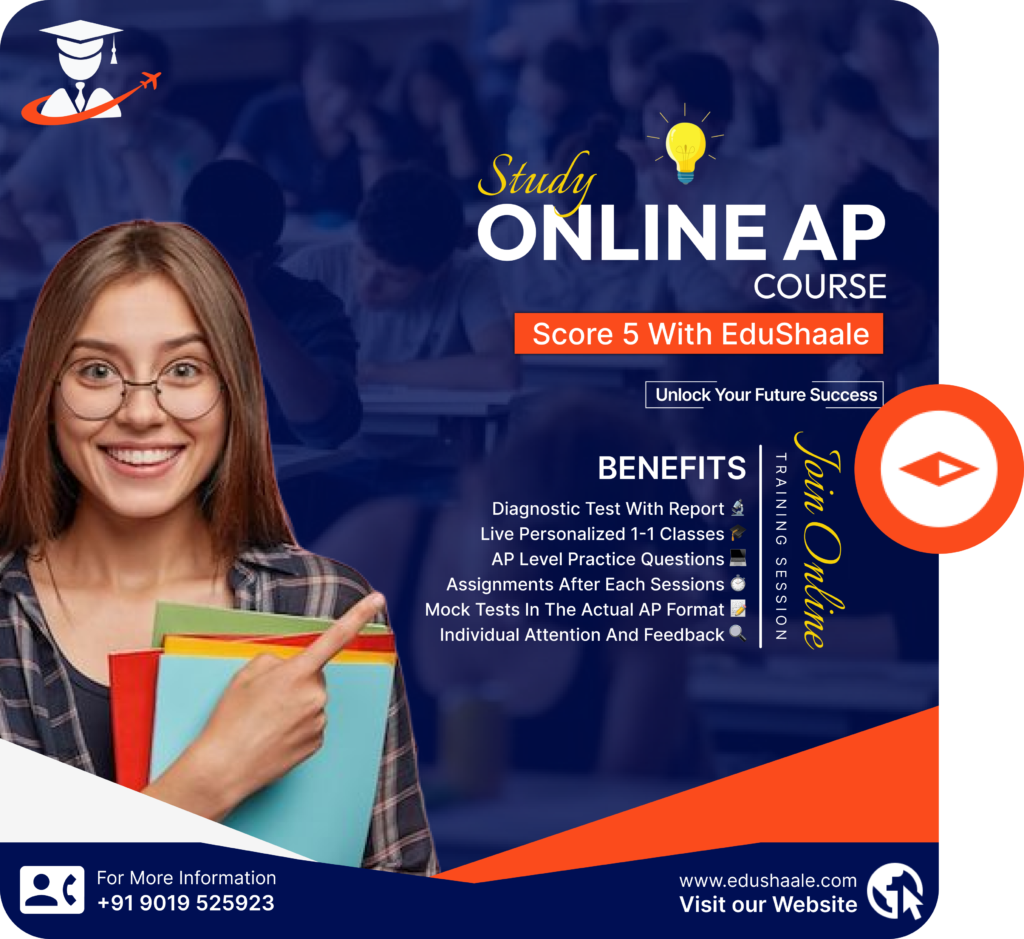AP CS Principles Classes Online
Are you Looking for the AP Computer Science Principles Classes? Worry not, EduShaale has got your back
- No credit card required
- Free Demo Session
- Personalized 1-1 Classes
- Flexibile & Affordable


AP Coaching Program
- 1-1 coaching from Certified AP Trainers per subject
- 5000+ Practice Questions and Drills
- 1000+ Question Bank
- 5+ AP Style Mock Tests
- 50+ Topic Based Tests(On Demand Generation)
- 10+ years AP Past Exam Questions
- 20K+ Trusted AP Aspirants
- Parent Connect, Progress Tracking & Regular Follow-up
- 4.9/5 Rated by AP Aspirants
A high AP score not only allows you to reduce your overall tuition fee and save time, but it also increases your chances of entrance into your dream and even allows you to be considered for scholarships.
AP CS Principles Structure
70 multiple-choice questions | 120 minutes | 70% of score | 4 answer options
- 57 single-select multiple-choice
- 5 single-select with reading passage about a computing innovation
- 8 multiple-select multiple-choice: select 2 answers
The AP Computer Science Principles end-of-course exam has consistent question types, weighting, and scoring guidelines every year, so you know what to expect on exam day.
30% of score
- Create performance task program code, video, and student-authored Personalized Project Reference | 9 hours in-class
- 2 written response questions | 60 minutes end-of-course exam
The second section of the AP Computer Science Principles Exam consists of a through-course Create performance task where you will develop a computer program of your choice an end-of-course written response section where you will demonstrate your understanding of your Create performance task by answering four prompts. You will be provided 9 hours of in-class time to complete your program, video, and develop a Personalized Project Reference.
On the end-of-course exam, you will respond to two questions related to the code in your Personalized Project Reference. The two questions include four distinct prompts: Written Response 1, Written Response 2(a), Written Response 2(b), and Written Response 2(c). You will have access to your Personalized Project Reference while responding to these prompts. The four categories listed below align to the four prompts.
Prompt Category | Students should be prepared to: |
Written Response 1: Program Design, Function, and Purpose
| Students should be prepared to respond to prompts about their program that assess any of the following learning objectives:
|
Written Response 2(a): Algorithm Development
| Students should be prepared to respond to prompts about their program that assess any of the following learning objectives:
|
Written Response 2(b): Errors and Testing
| Students should be prepared to respond to prompts about their program that assess any of the following learning objectives:
|
Written Response 2(c): Data and Procedural Abstraction
| Students should be prepared to respond to prompts about their program that assess any of the following learning objectives:
|
Course Content
The Computer Science A Exam will assess your comprehension of the programming concepts covered in the course units, as well as your ability to read and write computer program code.
Creative Development
You’ll learn how important collaboration is in developing programs and how to use an iterative process in your work.
Topics may include:
- Collaboration
- Program design and development
On the Exam
10%–13% of exam score
Data
You’ll explore how computers handle data and how data can be used to produce new information and solve problems.
Topics may include:
- Data compression
- Extracting information from data
On the Exam
17%−22% of exam score
Algorithms and Programming
You’ll learn how to use algorithms and abstractions to create programs that solve problems or to express your own creativity.
Topics may include:
- Developing algorithms
- Simulations
- Algorithmic efficiency
On the Exam
30%−35% of exam score
Computer Systems and Networks
You’ll explore how computer systems and networks work and how using multiple computers to divide tasks can speed up processes.
Topics may include:
- The Internet
- Parallel and distributed computing
On the Exam
11%−15% of exam score
Impact of Computing
You’ll examine the effects computing has had on societies, economies, and cultures and consider the legal and ethical responsibilities of programmers.
Topics may include:
- The digital divide
- Computing bias
- Safe computing
On the Exam
21%−26% of exam score
Why us for your AP Computer Science Principles Classes?
At EduShaale, we take immense pride in our commitment to providing a truly personalized and 1:1 learning experience for each student. Our approach ensures that you receive not just education but individualized attention, targeted guidance, and a learning journey tailored specifically to your unique needs and pace.
Embark on a journey of comprehensive coverage of AP Computer Science Principles concepts with our program, featuring over 20+ hours of dedicated instruction. Immerse yourself in the subject matter, master essential topics, and build a robust foundation that goes beyond conventional teaching methods.
Recognizing that every student has a unique learning pace, our classes are meticulously paced according to your individual needs. This flexibility empowers you to grasp concepts thoroughly, ensuring a comfortable progression through the curriculum.
Homework assignments form an integral part of our program. Upon completing each unit, engaging homework is provided to reinforce your understanding and allow you to apply the knowledge acquired in a practical context.
We are unwavering in our commitment to ensuring that your doubts and questions are promptly addressed. Benefit from our unlimited doubt classes, providing you with ample opportunities to seek clarification and bolster your confidence in your understanding of the subject.
This invaluable opportunity allows you to analyze your performance, gain insights into your mistakes, and refine your test-taking strategies under expert guidance.
Collaboration among educators, students, and parents is pivotal for academic success. Experience the benefits of regular Parent-Teacher Meetings, where we discuss your progress, share insights, and address any concerns. This collaborative approach creates a supportive learning environment that goes beyond the ordinary.
Score A Perfect 5/5 on AP
We're so confident that you'll be happy with our coaching that we offer a 100% satisfaction guarantee.
P.S. We're currently offering a special discount to new students.
